History in the Making: The 30th Anniversary of Disney’s “Pocahontas”
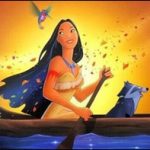
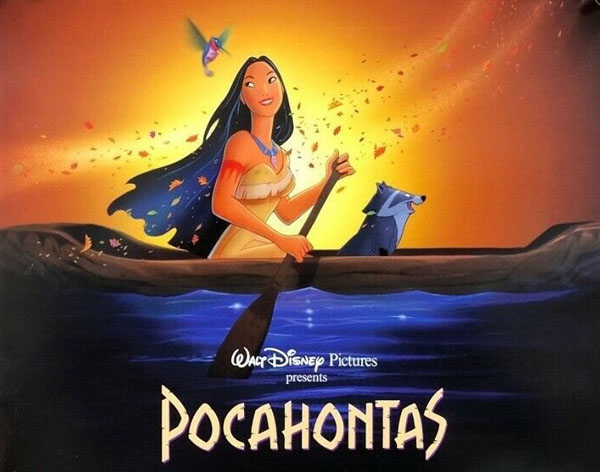
On June 11, 1995, the headline on the cover of the New York Daily News read: “‘Poca’ Party.” Underneath was an aerial picture of the 100,000 people who gathered the day before for the premiere of Disney’s Pocahontas in New York City’s Central Park, where they watched the film on four mammoth movie screens.
The 33rd animated feature from The Walt Disney Studio soared into the summer of 1995, like leaves that were a part of “The Colors of the Wind,” with the force of a grand event. It landed squarely in the midst of Disney’s Animation Renaissance, where the medium had made a comeback few could have envisioned, with Pocahontas arriving one year after the Studio’s record-breaking The Lion King.
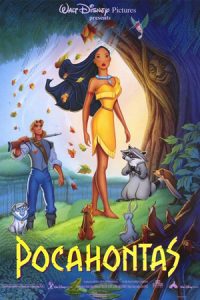 Hard to believe, but Pocahontas celebrates its 30th anniversary this month. Based loosely on historical events, it’s the story of the title character, the independent daughter of the Powhatan Chief, and the romance that develops between her and Captain John Smith, who journeys from England to the New World with other settlers. As the tensions arise between the natives and the settlers, it’s Pocahontas who helps prevent an all-out war.
Hard to believe, but Pocahontas celebrates its 30th anniversary this month. Based loosely on historical events, it’s the story of the title character, the independent daughter of the Powhatan Chief, and the romance that develops between her and Captain John Smith, who journeys from England to the New World with other settlers. As the tensions arise between the natives and the settlers, it’s Pocahontas who helps prevent an all-out war.
Pocahontas, co-directed by Mike Gabriel and Eric Goldberg, featured the voices of Irene Bedard as Pocahontas (with Judy Kuhn as the character’s singing voice), Mel Gibson as John Smith, Russell Means as Chief Powhattan (with Jim Commings as the singing voice), David Odgen Stiers as the voice of the villain, Governor Ratcliffe, and his manservant, Wiggins, Linda Hunt as the magical Grandmother Willow, who guides Pocahontas, Michelle St. John, a Pocahontas’ friend, Nakoma, James Apaumut Fall as Kocoum, a member of the tribe who wants to marry Pocahontas, and Billy Connolly, Joe Baker, and Christian Bale, as settlers Ben, Lon and Thomas (respectively) who come to the New World with Smith.
After its event premiere in Central Park on June 10th, Pocahontas opened everywhere on June 23rd. To celebrate the film’s thirtieth anniversary, what follows is insight from several of the artists who worked on the film, taken from interviews conducted around the time that Pocahontas debuted:
 Co-director Mike Gabriel first pitched the idea of Pocahontas at one of the Disney Studio “Gong Show” meetings. Modeled after the 1970s game show and talent show of the same name, artists could attend these meetings and present an idea for a future animated feature to Studio leadership. If the leadership team didn’t feel that it would work, the pitch would receive the “Gong.” If you didn’t get “gong-ed,” it moved forward.
Co-director Mike Gabriel first pitched the idea of Pocahontas at one of the Disney Studio “Gong Show” meetings. Modeled after the 1970s game show and talent show of the same name, artists could attend these meetings and present an idea for a future animated feature to Studio leadership. If the leadership team didn’t feel that it would work, the pitch would receive the “Gong.” If you didn’t get “gong-ed,” it moved forward.
When Gabriel pitched Pocahontas, he created a mock “one sheet” movie poster. The poster featured the character Tiger Lily from Peter Pan, with the title “Pocahontas” splashed across it. Thankfully, it wasn’t met with a “Gong.” Gabriel remembered the meeting:
“Basically, I just didn’t want to bore them [laughs]. Some people get up there and do a ten-minute story outline that’s just boring as hell. So, I figured I had faith in the title, and if the title hooks them, they’ll ask questions, and they’ll get information that way. So, it seemed to work, even with that Tiger Lily ‘rip-off.’[laughs]”
The Pocahontas team conducted extensive research during the early stages of film production. This included trips to Jamestown, Virginia, where the film and the events took place, as well as meetings with numerous members of the Native American community and an immersion into their culture. Co-director Eric Goldberg said of the research:
“We really wanted to present certain things in this film as interesting to our audience. It would have been very easy, for example, for us to make a film about Native Americans that included teepees, totem poles, and big, long, feathery headdresses, the way people are used to seeing those images from Southwest Native Americans. But we didn’t want to do that. So, we did go back to Virginia, and we did go to the Jamestown settlement and museum. And we met with the surviving members of the of Powhatan nation and spoke to them to get a flavor of what they were like and what they found important.
“They found a sense of community very important. They wanted to see that portrayed in the film. I think we’ve done that. The fact is that we could take their dwellings, take their dress, take the types of utensils that they use, and make that interesting because it is unique. They care about nature and giving back to the earth. We wanted to put that into the movie. There was a lot of attention paid to all of that.”
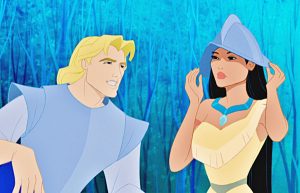 One of the film’s iconic moments is the scene in which Pocahontas and John Smith meet for the first time. It all unfolds compellingly and quietly in front of a waterfall. Glen Keane, who served as supervising animator for Pocahontas and also storyboarded this sequence, discussed how this dramatic moment came to be:
One of the film’s iconic moments is the scene in which Pocahontas and John Smith meet for the first time. It all unfolds compellingly and quietly in front of a waterfall. Glen Keane, who served as supervising animator for Pocahontas and also storyboarded this sequence, discussed how this dramatic moment came to be:
“The more I thought about it, I said, ‘Well, how did it work out for me when I met my wife?’ It was kind of a love-at-first-sight thing. I met her at a movie in 1972, on line, to see The Godfather. We were both seniors in high school. This girl was standing behind me, and I turned around, and she was there, and I don’t remember anything that she said. But I remember that whole time; I remember the orange blossoms in the air, I remember the temperature, the feelings that were there. I thought this is what this moment [in Pocahontas] has to be. It has to be something bigger than life, beyond just these two people standing there. The place where they met was very important. To have it in front of this waterfall, with just the roar of the waterfall behind them, the mist slowly revealing Pocahontas, kind of like clouds swirling around, made it very ethereal.
“She knows that she wants to run, but she also knows that she wants to stay. She’s been tracking and following him. There’s this very subtle little thing where her tension is just to lean off to screen right and run away, but, if you watch the scene, she slowly, very slowly, inches over to the left, and her head drops down slightly, which says, ‘I’m going to stay here for a moment.’ Then, he moves a little bit; then she looks at his gun, he drops the gun. Everything is very, very subtle.”
The songs in Pocahontas were by Alan Menken, with lyrics by Stephen Schwartz (who would go on to craft Wicked). They included “Just Around the Riverbend,” “Mine, Mine, Mine,” and the Oscar-winning “Colors of the Wind.” In a 1998 interview, discussing why the Broadway-style musical seemed so at home in animation, Schwartz referred to Pocahontas:
“In a stage musical, one of the most effective moments you can have is having a really fine singer standing in the center of the stage by his or herself singing for three or four minutes. That can be one of the best things in the show. You can’t get away with that in film. My stock line is, ‘If you’re going to write a ballad for a feature, the singer better be going over a waterfall in a canoe! [laughs]'”
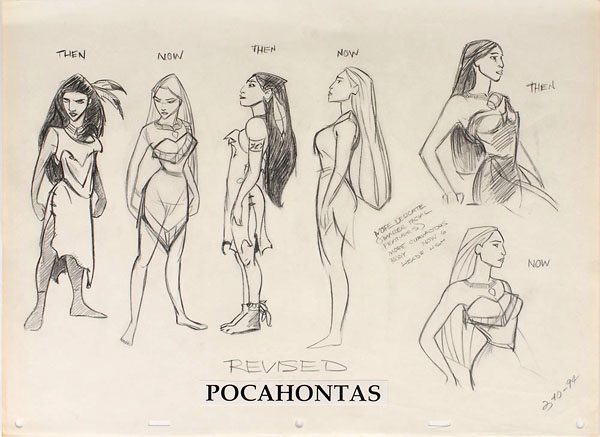
The look of Pocahontas was influenced by artist Eyvind Earle and his work on Disney’s classic Sleeping Beauty (1959), where he created a distinctive, clean, and vertical style that is unique to that Disney film. Eric Goldberg discussed the challenges of bringing this style to Pocahontas:
“The design of the film that we chose, from the design of the characters to the design of the backgrounds and the general tone of the movie, is completely unforgiving, in that the design itself is very crisp, but there aren’t a lot of round edges or circles in it and things that are ‘squashy and stretchy,’ that you have a lot of cartoon liberty with. So, it means that every little nick in the animation that’s a mistake or every little line in clean-up will show. It is a very daunting, this task that we set for everybody, and they just did it beautifully.”
Through its artistry, songs, and story, Pocahontas provides a message that still resonates thirty years later, as Mike Gabriel discussed in 1995:
“To me, it’s as simple as our similarities are much greater than our differences. Even though we like to rant and rave that we’re all completely different and each nation and each culture has its own idiosyncrasies and separate ideas, I think what we show in the movie is that we’re not all that different.”
